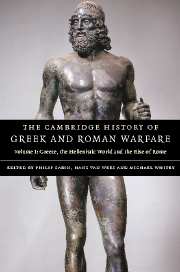Book contents
- Frontmatter
- Introduction: The Historiography of Ancient Warfare
- Part I Archaic and Classical Greece
- Part II The Hellenistic World and the Roman Republic
- 10 International relations
- 11 Military forces
- 12 War
- 13 Battle
- 14 Warfare and the state
- 15 War and society
- Chronological Table
- Glossary
- List of Ancient Authors
- Bibliography
- Index of ancient passages cited
- General index
- Map 1 The western Mediterranean
- Map 3 The Near East
- References
12 - War
from Part II - The Hellenistic World and the Roman Republic
Published online by Cambridge University Press: 28 March 2008
- Frontmatter
- Introduction: The Historiography of Ancient Warfare
- Part I Archaic and Classical Greece
- Part II The Hellenistic World and the Roman Republic
- 10 International relations
- 11 Military forces
- 12 War
- 13 Battle
- 14 Warfare and the state
- 15 War and society
- Chronological Table
- Glossary
- List of Ancient Authors
- Bibliography
- Index of ancient passages cited
- General index
- Map 1 The western Mediterranean
- Map 3 The Near East
- References
Summary
introduction
In the first half of the fourth century a number of factors coincided to foster revolutionary change in military practice. These included a move to a new and bolder type of strategy, innovations in equipment and tactics, the increasing use of mercenaries, a heightened sense of military professionalism, improvement in methods of fortification, experimentation in innovative weapons (such as torsion artillery) and the development of military training manuals. Some of these innovations were developed within Greece: for example, a general lightening of equipment, the deepening of phalanxes, and the use of combined arms. Others were borrowed, as the Greeks came into contact with various other styles of fighting: the pelta or crescent shield was borrowed from the Thracians and the long spear for light infantry (apparently) brought back from Egypt by Iphicrates. The expanding boundaries of the oikoumenê in the latter fourth and third centuries both spread Greek innovations to other peoples – such as the Romans – and brought the Greeks new military techniques and practices. Contact with the Celts promoted increased use of the sword and, possibly, a new type of saddle. The Parthians contributed armoured cavalry and the Indians battle elephants.
The role of the Carthaginians in the military developments of the fourth century has generally been undervalued. During a century-long struggle over control of Sicily, the Phoenicians of north Africa certainly influenced Greek development of siege equipment and quite possibly the use of relays in attacks on city walls. Punic armies were remarkably large for the period, ranging up to 70,000 men, with the sort of combined force – heavy and light infantry and cavalry – that is associated with later Hellenistic warfare.
Keywords
- Type
- Chapter
- Information
- The Cambridge History of Greek and Roman Warfare , pp. 368 - 398Publisher: Cambridge University PressPrint publication year: 2007
References
- 4
- Cited by

